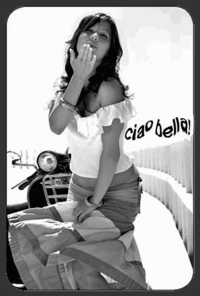Ciao
The word ciao (pronounced "chaow" /tʃao/) is an informal Italian verbal salutation or greeting, meaning either "goodbye" or "hello". Originally from the Venetian language, it was adopted by Italian and eventually entered the vocabulary of English and of many other languages around the world. The word is mostly used as "goodbye" in English, but in modern Italian, modern Venetian and in other languages it may mean "hello", "goodbye", or both.
Etymology
The word derives from the Venetian phrase s-ciào vostro or s-ciào su literally meaning "I am your slave". This greeting is analogous to the Latin Servus which is still used in a large section of Central/Eastern Europe. The expression was not a literal statement of fact, of course, but rather a perfunctory promise of good will among friends (along the lines "if you ever need my help, count on me"). Indeed, to this day the greeting ciao is used in Italy only among peers, family members, and close friends, being considered too informal to use with superiors or strangers.
The Venetian word for "slave", s-ciào ['stʃao] or s-ciàvo, is cognate of Italian schiavo and derives from Latin sclavus. The institution of slavery existed in Venice during the very Early Middle Ages when the slaves were usually young Tartars bought in Tana (near Azov) or, more rarely, Muslims captured on the sea during wars. In the High Middle Ages the slaves could also be non-Catholic Christians from the Balkans, such as Slavs and Greeks. In Venice there were also few slaves that came from Black Africa (as depicted, eg., by Carpaccio). The status of slaves in Medieval Venice was not very different from that of servants, and they were often freed in testaments.
The greeting expression was eventually shortened to ciào [tʃao], lost all its servile connotations and came to be used as an informal salutation by speakers of all classes. The word s-ciào is still used in Venetian and in Lombardian as an exclamation of resignation, as in Oh, va be', s-ciào ("Oh, well, never mind!"). A Milanese proverb/tongue-twister says Se gh'inn gh'inn, se gh'inn no s-ciào ("If there is [money], there is; if there isn't, no problem").
Spread
The Venetian ciào was adopted by the Italian language, with the spelling ciao, presumably during the golden days of the Venetian Republic. It has since spread to many countries in Europe, along with other items of the Italian culture. In the late 19th and early 20th century, the salute spread to the Americas—especially Colombia, Uruguay, Paraguay, Peru, Ecuador, Chile, Brazil, and Argentina—largely by way of Italian immigrants.
Ernest Hemingway's novel A Farewell to Arms (1929), which is set in northeast Italy during World War I, is credited with bringing the word into the English language Today it is not uncommon for native/adopted speakers of the English language to use "ciao" instead of "goodbye" in informal talk.
Usage as greeting
In contemporary Italian usage, ciao is interchangeable for both an informal hello and goodbye, much as aloha in Hawaii or shalom in Israel. In other countries, it has come to have more specific meanings. The following list summarizes the spelling and uses of this salutation in various languages and countries.
- Bosnian: ćao
- Bulgarian: чао, chao; ("goodbye")
- Croatian: ćao
- Czech: čau ("hello" or "goodbye")
- English: ciao ("goodbye")
- Esperanto: "ĉaŭ" ("goodbye", rarely "hello")
- Estonian: "tšau" ("hello" or "goodbye")
- Finnish: "tsau", also "tsaukki" ("hello" or "goodbye")
- French: ciao, sometimes (frequent in Quebec, Canada) tchao ("goodbye")
- German: ciao, sometimes tschau ("goodbye")
- Hungarian: csáó or the more informal csá ("hello or "goodbye")
- Interlingua: ciao ("goodbye")
- Italian: ciao ("hello" or "goodbye").
- Latvian: čau ("hello" or "goodbye")
- Lithuanian: čiau ("goodbye", rarely "hello")
- Macedonian: чао, čao ("goodbye")
- Maltese: ċaw ("goodbye"); also ċaw ċaw ("bye bye")
- Portuguese: tchau ("goodbye"); esp. in Brazil, also diminutive tchauzinho
- Romanian: ciao or rarely ciau ("goodbye", less frequently "hello")
- Russian: чао, chao; ("goodbye"); also jokingly - чао-какао, chao-kakao
- Serbian: ћао, ćao ("goodbye", frequently "hello") - this developed into: ћаос, ćaos.
- Slovak: čau ("goodbye", less frequently "hello")
- Slovene: čao or čaw ("hello" or "goodbye"); also čaw čaw ("bye bye")
- Spanish, esp. in Latin America: chau or chao ("goodbye")
- Turkish: çav ("goodbye")
- Venetian: ciào ("hello" or "goodbye")
- Vietnamese: chào ("hello" or "goodbye")
In some languages, such as Latvian, the vernacular version of ciao has become the most common form of informal salutation.
The greeting has often several variations and minor uses. In Italian, for example, a doubled ciao ciao means specifically "goodbye". Tripled or quadrupled it means "Bye, I'm in a hurry!". Pronounced with a long [a], it means "Hello, I'm so glad to meet you!" (be it sincere or hypocritical); with a lengthened [i] (so that it sounds like a meowing of a cat) it has flirtatious implications.
Gesture
In Italy, the word is associated with a specific gesture (fare ciao con la mano, "to do "ciao" with the hand"). The fully open hand, palm forward and fingers up, is held at shoulder level or higher, and waved left to right, pivoting on the stationary wrist. For more emphatic gesturing, the forearm may be pivoted at the elbow, or the whole arm is held up straight and pivoted at the shoulder. The gesture is seen as somewhat childish and is therefore used mostly by and for children and women, or when someone is departing for a long trip.
In spite of its present association to the word ciao, the gesture probably had an independent origin and may be much older than the word. The gesture is common in many other countries, with similar meanings, but is not necessarily associated to the local"ciao" word.
